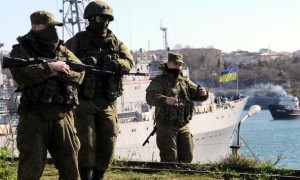UNITED NATIONS — Less than a week after the spectacular closing ceremony of the Sochi Winter Olympics, Russian President Vladimir Putin decided for an encore and invaded the sovereignty of neighboring Ukraine.
The chill winds of the Cold War have returned to Europe and the halls of diplomacy.
Taking advantage of Ukraine’s civil and political unrest which had toppled the ruling pro-Russian regime in Kiev, allegedly causing anxiety among Russian ethnic minorities in parts of this vast land, Putin decided to settle the conflict the old fashioned way; military intervention.

Russian forces, operating from pre-existing and treaty sanctioned naval and air bases in the strategic Crimean peninsula, rapidly deployed to blockade Ukrainian military facilities and seize airports. Crimea has a majority ethnic Russian population which appears to welcome Moscow’s embrace. Significantly it hosts the Russian fleet’s only warm water ports.
A visibly shaken Ukrainian UN Ambassador Yuri Sergeyev briefed the Security Council and later correspondents to denounced the fast deteriorating situation in his country as Russian aggression.
Ukraine which was part of the former Soviet Union, gained its independence in 1991 after the fall of the communist regime in Moscow. In late 2013, while the Ukrainian majority rallied in favor of closer economic integration with the European Union, the ruling pro-Russian regime tilted closer to Moscow, thus setting off the crisis.
Intense diplomacy by Germany and Poland tried to bridge the gap between the two political camps to little avail. But an obscene verbal quip by U.S. Assistant Secretary of State Victoria Nuland, a pro who does know better, in a monitored phone call in Kiev to “F__ the EU” (European Union), caused a major embarrassment and a damage control problem between Washington and the Europeans, when the focus should have been on deterring Moscow’s impending moves.
The overthrow of Ukraine’s corrupt President Viktor Yanukovych by a wide range of dissidents was the last straw as far as Putin was concerned.
So is Vladimir Putin gambling or playing political chess in Ukraine? Since the times of Catherine the Great, Crimea has been a vital strategic Russian asset on the southern flank facing the Ottoman Turks. The region was the scene of the bloody Crimean War in the 1850’s which pitted the massed armies of Britain, France and Turkey against Czarist Russia.
Putin plays by an historic and neo-nationalistic rulebook—Russian nostalgia and retro Soviet swag are mixed with ruthless realpolitik politics.
Many of Ukraine’s problems are rooted in Soviet era policy. In 1954, almost to the day of the current crisis, former Soviet leader Nikita Khruschev gave Russian Crimea to Ukraine. Equally in the wake of WWII, Stalin dismembered large parts of eastern Poland and ceded the territory to Ukraine. Today these same regions form a core of the pro-European parts of the country. Ironically, the Soviet postwar political cartography set a time bomb which threatens all sides.
Thus, modern Ukraine is pulled between the majority who face West towards Europe and are Catholic versus the large Russian speaking and Orthodox minority in the East who look towards Moscow. Crimea clearly is in the Russian sphere of influence, and on this reality Putin plays his ethno/political cards.
Ukraine’s Ambassador Sergeyev warned that the Russians may be trying to break off Crimea from Ukrainian sovereignty as Moscow did in the Georgia War in 2008, in which two “Russian ethnic” enclaves were seized from Georgia and set up as “independent republics.” The Ambassador called for the international community to provide “moral and political support ” for a free Ukraine.
Responding to the political theatrics of “an endangered Russian community” in Crimea, Putin’s plans to set up an “enclave Republic.” A planned “referendum” on whether Crimea should join Russia has been condemned by the USA and the European Union. A second scenario emerges; will Putin then look to a “threatened minority” in the eastern Ukraine and try to revive a new version of the old Ukraine SSR? A nightmare scenario sees Putin expanding to the Western parts of Ukraine.
So do we see salami tactics or the clear clarion call of historic irredentism?
But the crisis comes amid the perception of American strategic ambivalence and foreign policy fuzziness concerning Russia and Central Europe for that matter. Few in the Obama Administration know or understand the streams of Russian history.
Remember former Secretary of State Hillary Clinton’s celebrated “Reset” with Russia Policy in 2009? Beyond the wishful sentiments, and the stage prop red reset button, even the linguistic translation was clumsy.
The USA and the European Union must make a clear and convincing case to Russia that serious economic and commercial sanctions will follow any “reset” of Ukraine’s borders and its territorial integrity. Tough talk is not a policy, consequences are.
John J. Metzler is a U.N. correspondent covering diplomatic and defense issues. He writes weekly for WorldTribune.com. He is the author of Transatlantic Divide ; USA/Euroland Rift (University Press, 2010).


You must be logged in to post a comment Login